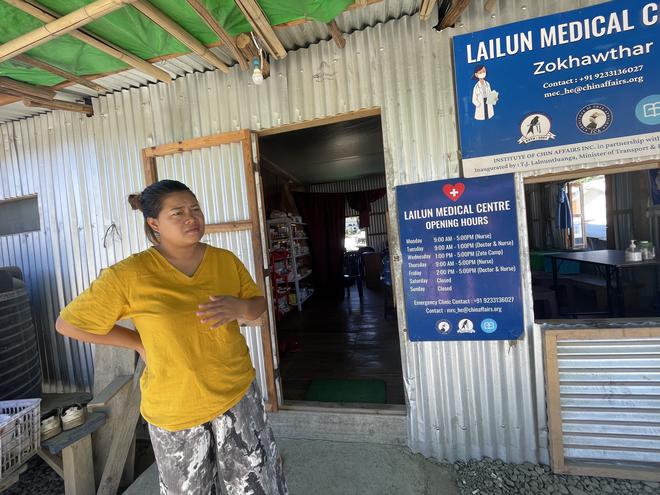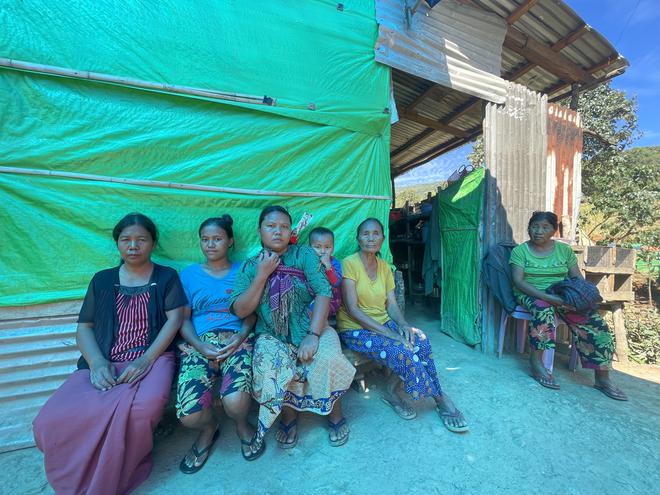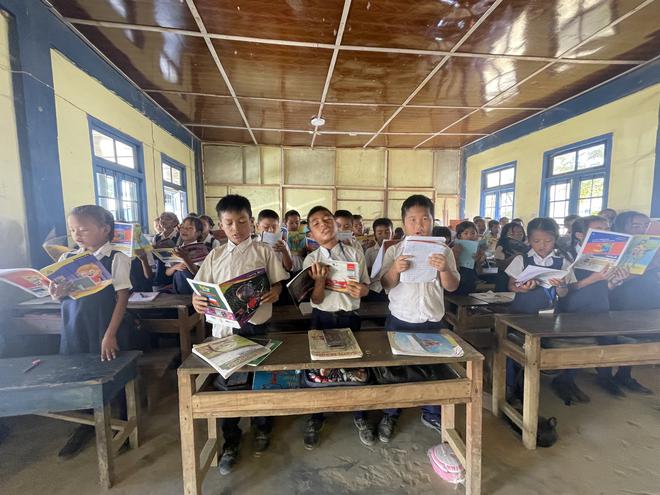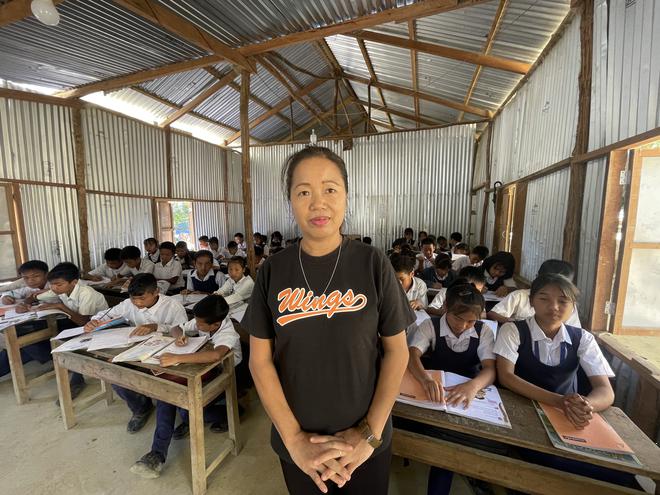Soon after the Tatmadaw, or Myanmar’s military, seized power in a coup d’etat in February 2021 by displacing the National League for Democracy (NLD)-led government, Sumi, 18, fled the country. She crossed the border into India and finally secured a job in Treasury Square, the administrative hub of Aizawl, Mizoram’s capital.
Sumi was not too worried about leaving her home in Tedim, the second largest town in Myanmar’s Chin State, for Aizawl, covering 255 kilometres over five days by public transport. “She knew she would be among her own people in this foreign land that is much safer and more peaceful than ours,” says Margaret Ngaihi, Sumi’s family acquaintance.
Sumi became Margaret’s apprentice. Margaret, too, had left Tedim about 40 years ago to work at the house of L.R. Sailo, a former director of Mizoram’s Information and Public Relations Department at Treasury Square. Margaret says Sumi, from the Chin community, did not take long to settle down at the house of Sailo, a Mizo.
Margaret had left Tedim under similar circumstances in the 1980s. Myanmar, then called Burma, was under the military dictatorship of Ne Win. The Free Movement Regime (FMR) which promotes local trade and allows residents along the 1,643 km-long India-Myanmar border to move up to 16 km into each other’s territory without travel documents, was not in place then; the agreement between India and Myanmar was implemented only in 2018. She married a Mizo and they had two sons.
“The Chins and Mizos belong to the same ethnic stock. They were inhabiting Zogam (the land of the Zo people) for ages before the British divided our homeland in the 1800s. Marriages and other social interactions between people on either side of the international border are quite common in these parts. It is also not unusual for children in Myanmar to study in Mizoram,” says Sailo. Zogam comprises present-day Mizoram, the Chin State of Myanmar, and areas beyond.
Margaret has occasionally visited her relatives in Tedim. “The civil war has been forcing our people to hunt for jobs abroad. The younger lot in Myanmar prefer Malaysia, which is where Sumi lives now, but we cannot think of a better place than Mizoram, the land of our own people,” Margaret says. Mizoram currently shelters about 35,000 people displaced from Myanmar, Bangladesh, and Manipur.
She is not aware of the geopolitics in the region, specifically about Manipur’s insistence on fencing the India-Myanmar border to block the entry of refuge-seekers from the civil war-torn country. In January, Home Minister Amit Shah announced that the Centre would fence the entire border to restrict free movement into India. But discussions in the neighbourhood on the fencing have made her understand that it might not be easy for her people to travel across the border as easily as she and Sumi did, four decades apart.
In January, Sangthankima, 63, a social worker who runs Mizoram’s largest orphanage, Thutak Nunpuitute Team, was awarded the Padma Shri by the Indian government. While he is happy about the recognition, he is now worried. He faces the prospect of losing easy access to the orphanage and rehabilitation centre run by his charitable organisation at Tahan, in the Sagaing Division of Myanmar. The centre at Tahan houses about 100 orphans and is the smallest of his five centres. The other centres are in Champhai, Kolasib, Aizawl, and Lunglei — all in Mizoram.
Waiting for calm
Not everyone eyes Mizoram for a living. Unlike Margaret and Sumi, Julali, who is her late 20s, was working as a nurse at a 200-bed government-run hospital in Falam, the former headquarters of Myanmar’s Chin State. She joined the Civil Disobedience Movement after the military coup in 2021. She was forced to quit her job and be on the run until she reached Zokhawthar, a border town in Mizoram, in the autumn of 2022. Two of her pro-democracy colleagues at the Falam hospital also made it to Zokhawthar.

The three of them were entrusted with running the makeshift Lailun Medical Centre in Zokhawthar, referred to as the ‘refugee clinic’ by the Mizo people. The centre primarily treats sick or injured Myanmar nationals who have been displaced. It is located about 110 km from their hospital at Falam, which had the highest concentration of Myanmar nationals displaced by the civil war, which is being fought between armed civilian groups called the People’s Defence Forces (PDF), which are allied to the self-declared National Unity Government in exile, and the Buddhist-dominated military.
The Lailun Medical Centre was set up by the Myanmar-based Institute of Chin Affairs with help from community-based organisations such as the Young Mizo Association and church bodies. The Mizos, the dominant community in Mizoram, are ethnically related to the Chins of Myanmar, the Kuki-Zos of Manipur, and the Kuki-Chins of Bangladesh.
The door of the medical centre faces the road that brought Julali from Falam to Khawmawi, Myanmar’s border town, which is connected to Zokhawthar by a 30-metre steel bridge across the Tiau River. Once the passage for formal trade between India and Myanmar, the bridge has been closed to traffic since the COVID-19 pandemic but residents are allowed to walk across up to a certain point on either side of the border.
The PDF and its associated groups have taken control of much of Chin State over the past few months forcing more than 500 Myanmar soldiers to flee to India from where they have been evacuated to Mandalay and other Myanmar military bases.
Thanks to intuition, and knowledge of the history of the conflict, Julali knows that it could be months before she can return to Falam. “Thankfully, the fighting cannot get any closer than this (800-900 metres beyond the Tiau river). We can only go back when the fighting stops completely, and I am not sure if it will be anytime soon although I hear the junta (military) is losing ground,” Julali says. She yearns to work again at the Falam hospital in a peaceful atmosphere. Her co-workers at the hospital are currently divided unequally into pro-democracy and pro-junta groups.
Her biggest worry is India’s move to fence the border and end the FMR, which might not let her take refuge in Mizoram if things at home go wrong again. “We cannot stay here forever. Our country has been caught in one conflict or the other, and we may have to seek refuge in India again after we go back home,” she says.
Ebb and flow
Large swathes of India’s present-day Northeast were under the reign of Burmese king Bagyidaw until he lost the first of the three Anglo-Burmese Wars in 1826 and signed the Treaty of Yandaboo. This led to the demarcation of the territories of British-ruled India and Burma, similar to the current alignment of the border between the two countries. The invisible border through hills and jungles hardly made a difference for “separated” locals, belonging to the same ethnic stock and dependent on each other for local trade, farming, and social events. India’s independence in 1947 and Burma’s in 1948 did not impact the movement of people across the porous border much, except during military operations against Northeast-based extremist outfits that have been using Myanmar as a haven. The visits across the border became more frequent when the two countries agreed in 2018 to implement the FMR. India suspended the FMR in September 2022, given the continued escalation of the refugee crisis after the military coup in Myanmar.
While some 2,000 Myanmar nationals, mostly the Chin people, took refuge in Manipur, the number of displaced people who entered Mizoram touched the 40,000-mark within a year of the coup. The number dropped to about 33,000 by the end of October last year and increased again less than a month later after the civil war reached the Mizoram border.
“The number fluctuates as the Myanmar nationals living close to the border with India come and go depending on gunfights or bombings from the air. The Champhai district is currently sheltering 12,432 Myanmar nationals,” says V.L. Hruaimawia, the Mizoram government-appointed liaison officer for the District-Level Committee on Myanmar Refugees.

Almost half the refugees in the district are in Zokhawthar and adjoining villages. Among them is Mawihlengkim, a primary school teacher from Lumbang near Falam. She is among the earliest inmates of Bethel Camp, the largest of the three in and around Zokhawthar housing 503 people.
“We were four teachers at a government-run school teaching all subjects to about 30 students from nursery to Class 4. The other teachers who joined the Civil Disobedience Movement and the students are hopefully safe wherever they are,” she says, insisting that life in Myanmar was not so uncertain before the Tatmadaw overthrew the NLD-led government in February 2021.
She arrived in Zokhawthar with her three children on the back of a mini-truck almost two years ago. “Do they have any chance of growing up and studying in the land of our ancestors,” she asks.

Two of her children are among the 20 from the refugee camp enrolled at the Zokhawthar Government Primary School, about 1.5 km away. The school has 420 students and only 60 of them are locals. The enrolment in nine other schools in Zokhawthar, four of them private or run by missionaries, is also skewed in favour of refugees.
“How can we not allow the children of people facing a major humanitarian crisis to study in our schools? And they are our people with the same roots and culture divided into two nations without consulting our forefathers,” says Thangkunga Pachuau, a teacher at the school.
Partei Asangneihpari, who teaches English at the school, initially found it difficult to manage “so many children” – 50 of the 80 children in her class are Myanmar nationals – who could neither communicate in English or Duhlian, the Mizo tongue. “But they picked up the local language fast probably because each of them speaks at least four languages,” she says.

Dealing with the older refugee children has been tougher for the teachers, especially because they suffer bouts of depression caused by the memories of violence back home and the atmosphere of hopelessness in the refugee camp.
“The scars of the civil war are not easy to forget. Unlike many of our brothers and sisters caught in the war, we are fortunate to be safe across the Tiau. The people of Mizoram are treating us well but we cannot live at the mercy of people in a different country forever,” says Tumneithanga, a member of a committee of refugees in Zokhawthar. A farmer who left an agriculture plot of 1 sq. km behind in the Chin State’s Sekan, he keeps himself occupied with menial jobs.
Bilateral relations
Myanmar’s displaced Chins include several lawmakers and government officers who prefer to remain incognito. They are enthused by the news of the PDF and ethnic militias gaining ground against the junta, but are wary of the history of ethnicity-based conflicts in Myanmar and the possibility of the Tatmadaw bouncing back from setbacks. India’s strategic ties with the Myanmar military and conflicting views on the refugee issue – Manipur wants the border with Myanmar sealed while Mizoram prefers a status quo – are also causes of worry.
India is not a signatory to the 1951 United Nations Refugee Convention or its 1967 Protocol. It does not have a refugee law. Apart from instructing the security forces to push back the refugees, New Delhi was indifferent to requests from the Mizoram government for ₹10 crore as fiscal assistance to look after the displaced people although it agreed belatedly to help in kind. A sulking Mizoram government, then headed by Zoramthanga of the Mizo National Front, later ignored the Centre’s order to collect the biometric data of the refugees from Myanmar, an exercise that leaders of the party felt would discriminate against “people of our blood”.
Mizoram has a new government now, headed by Lalduhoma, who has been vocal about his party, the Zoram People’s Movement (ZPM), having inherited a State deep in a financial crisis. This triggered apprehension among the refugees about a possible change in the government’s policy. The ZPM has allayed such fears although it has admitted that it cannot stop the Centre from fencing the border and ending the FMR.
“How can we leave our own people in the lurch? We are passionate about the issue of Zo reunification. This passion makes our church organisations, individuals, and NGOs take care of the people displaced from Myanmar,” says Clement Lalhmingthanga, a retired Lieutenant Colonel who represents the Champhai South Assembly constituency.
Among the NGOs focused on the welfare of the refugees is the Village-Level Committee on Myanmar Refugees (VLCMR). “We may not be politically relevant to New Delhi but we hope our Central leaders have a humanitarian streak to reconsider the decision to cut off our brethren with a barbed-wire fence, however impractical it might seem given the terrain,” Biaktinsanga, a key functionary of the VLCMR, says.
The emphasis is on humanitarianism because many in Mizoram believe that the civil war in Myanmar is less of a factor than the ethnic conflict in Manipur for the decision to fence the India-Myanmar border. The Bharatiya Janata Party-led Manipur government wants its 390-km border with Myanmar fenced primarily to stop people of the neighbouring country from entering the State. The Manipur government has been blaming the ethnic conflict since May 2023 between the majority Meitei community and the Kuki-Zomi people on “infiltrators” from Myanmar.







